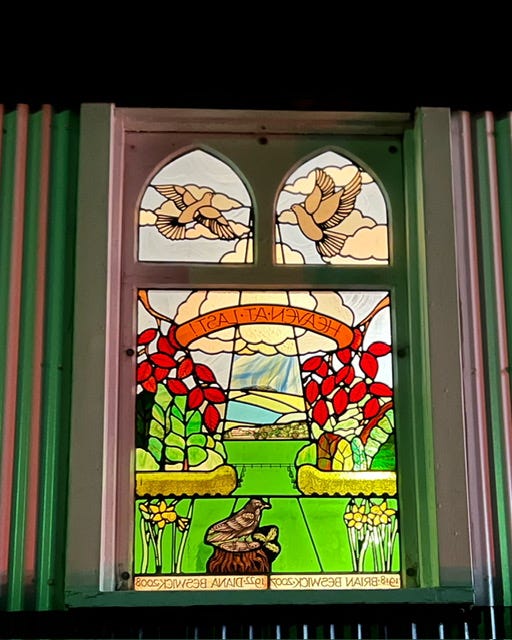Notes from the War Between Jackdaws and Crows
Plus: LAST CHANCE to claim 20% off annual subscription and take part in my online writing course: What to Look for in Spring

Today I want to tell you about how my office is also a hide from which I watch the war unfolding between the village jackdaws and crows, but first, to business:
Today is the last chance you can claim your 20% discount on an annual subscription to Notes from the Margin:
20% Off Notes from the Margin Annual Paid Subscription!
Hello Friend,Notes From the Margin with Wendy Pratt is a reader-supported publication. To receive new posts and support my work, consider becoming a free or paid subscriber. I’m delighted to offer you a 20% discount on my annual subscription to Notes from the Margin paid. There’s lots to enjoy in this thriving writing …
It coincides with the launch of my next online course, which starts next week (or tomorrow, for paid subscribers): What to Look for in Spring.






If you didn’t want to subscribe, you can join as email only by clicking on this link:
Now, to the war on the rooftops…

Every weekday morning my day begins with pulling on my dressing gown, switching on the little lamp in my office and opening the window, just a smidge, to let the sound of the village in. Then coffee is made, then work is planned and while all this happens just before 7am the sky is beginning to draw the light and the jackdaws begin to return from their overnight roosts.
They arrive in a scatter of sound; snooker balls on the break, a clatter of thin metallic caws that carry over the village roofs, while the birds themselves stream in, quick and agile, a steady flock of black wings against the ink or slate or white sky. First they flock into the beech trees that line the edge of the farm behind my house, then there is scrapping and arguing while, presumably, hierarchy is re-established before they begin to disperse onto the rooftops and onto the roads and paths in the village to get to work looking for food. They are studious in their work, their blue or yellow eyes turned to the ground, intelligent heads cocked, they march along in packs of two or three.
I think of this Polly Atkin poem often when I see their confident, intelligent examination of their environment, and hear their calls.
Jack Daw Strut and hop, head cocked. Bill-up posture. Sky-tumbler. Linear hierarchical order repeated through faultless falls. Acrobat soothsayer. Splintered midnight in flight. College bird, sea crow, chimney sweep bird. In French – tower crow – choucas de tours – steeple-jack. In Latin – Corvus Mondedula – money crow. Jack of coins. Jacques d’or. Labelled by home or haunt or habit. Love of the shine. Your bright slick image. Centuries repeating your own name in greeting chyak chyak chyak taught us the sounds as best as our soft mouths could catch. We parroted jack. Dubbed you simple – daw. In spring I watch you nest-build, exulting over sticks; twigs; clumps of tatty wool picked from barbed wire; moss, human hair, pruning fleece from a sheep as she sleeps. Any gap you find you will work on improving. Day after day I hear you calling ciao ciao ciao from the rooftops, tree tops, chimney pots, edge of the woods ciao ciao from the village green. I call you back Prince of Smokestack Chaplin Inquisitor of Stars Moon Eye Coin-in-a-Well. That which you love the best you share faithfully. All preening in pairs. When you quarrel with yourselves a war is massing on a distant horizon, a long term forecast. Thunderclouds flock when you gather, to mimic your sharp murmurations, to call in the rain. I know you are trying to tell me something. I know I could teach you to say it with meaning. ciao ciao ciao I squawk, signalling exit/arrival. A clatter of wings. I have set a dish of oil in the yard to catch you with your own reflection. Your blue-eyed baby is crying in alarm from the breach in our structure you cracked her into kae kaya kavka caddy ka-wattie caddess caddow cawdaw cathag jak-y-do chauk
Polly said, about the writing of this poem,
I’m very interested in folk knowledge, and how that that is reflected often in the naming of things, which is where I ended up started with Jack Daw: the various names for them in different languages; how those names echoed jackdaw habits and showed shared observations and beliefs across cultures and language barriers. I also wanted to interweave those with scientific observations which struck me as belonging, in some way, to the same field study.
I like this idea of the folklore merging with the scientific, seeping into the naming of things, of birds, of places, and then that merged knowledge meeting the conduit of the writer who then expresses it, through their own lens of experience, and that knowledge, that expression, then goes on to be one of the reference points in someone else’s knowledge.
This is a village of crows and jackdaws, and occasional rooks who seem to get along with anyone. I once saw a chough too, on the top road, looking bemused and uncertain, walking with rook friends. I can only imagine it had been blown off course and ended up here. They are a west coast bird really.
Such is their presence in the village that they have even made it into the stained glass windows of the little corrugated iron church, forever caught in Diana Beswick’s idea of heaven - the view onto the dales from the bottom of her garden.
Here, in the part of the village where I live, in the old ex council houses; ex farm labourer houses from the 1950s, it has been the jackdaws who dominate, nesting in the chimneys and watching the village from the roof tops. Until recently.
The crows are beginning to take over. It is not an all out war of claw and beak, but rather insidious, a gentle creeping into territory, a taking over of branch and chimney pot. It seems calculated, but am I simply overlaying my own human-strategy onto these clever birds? I first noticed the tension between crows and jackdaws a year or so ago, when, looking up from my computer on its battered old sewing table, surrounded by research books, I saw a jackdaw have its tail pulled by a crow on the roof opposite. The jackdaw, understandably upset, ran after the crow who simply sloped away as if it hadn’t done it. Slowly, over many months, this sort of behaviour increased. The crows refused to move from the roofs even while the jackdaws dive bombed them. There were more jackdaws nesting down the lane now. I watched a pair of jackdaws shout down a hole in a tree for three days until the squirrel that was living there with her babies, left in a panic. The jackdaw moved in. But they have always lived and nested in the beech trees here, I thought.
Last summer I heard a jackdaw mimicking a crow. It hadn’t got it quite right, there was something just off in the tone of the call - perhaps not quite as defiant as a crow’s call. I have only heard this a couple of times and I don’t know the meaning behind the behaviour. I want so desperately for it to be a kind of piss-take, a mocking of the crow hierarchy, but I imagine this is some sort of deterrent, or camouflage for the jackdaws. It was an interesting development in strategy. If it is strategy.
I wonder where instinct leaves off, and intelligence takes over. I wonder this about humans too. We seem to be driven by instinct but dress it up as intelligence, and I wonder if this is why the world is the way it is, so many people reacting to the fear they feel as tribal, primal animals, and using those big clever brains we carry around with us to build weapons, kill children, annihilate countries because of that fear. It is never as simple as that, of course. Or maybe it is.
The last week or two I’ve noticed another change. By the time I am sitting down with my sunshine yellow mug of molten black coffee, the morning air is full of the hoarse call of the crow and the beech opposite my window is already filled with crows on every branch by the time the jackdaws arrive, causing the jackdaws to bank up, into the morning, swerve and drop further away, in the second line of beech on the other side of the field.
All this while I work at my desk, the window at the back of the house where the sun now pours in on a morning, my office becoming a hide for watching the crows. I have taken to keeping my binoculars on my desk.
I used to feed them, throwing food onto the shed roof. In return I received a shiny penny left on my doorstep. I can’t feed them now, due to the seagulls who have worked out they can steal all food if they are quick enough. I have nothing against seagulls, but they are terrible for ripping bin bags open in the street, encouraged by people feeding them human food. A seagull could easily take the finger off a toddler in a pushchair, mistaking it for part of a sausage roll, I’ve seen them draw blood, so its best not to encourage them.
Sometimes I take a handful of nuts out when I go walking and the corvids recognise me, following me down the village, hopping and gliding from roof top to roof top until I make the Ch Ch Ch sound that alerts them to the incoming nut scatter and throw a handful down for them. Then they become shy, waiting for me to leave before descending. I pay special attention to a leucistic crow who seems to be an outcast. The people at the Hall are feeding him (or her) now. I see it waiting on the marble steps most days.
I feel a camaraderie with the village corvids, they are my neighbours. I like to think of them as a black, feathered chain reaching back and back to when the village was a longhouse and a scatter of wood and thatch houses, pigs in the woods, wolves in the hills. The general interconnectedness of everything. I like to place myself there too, reaching my fingers out to feather and brick, feeling myself in the long line of life.
And now it is time for my second coffee, and the seagulls have arrived and the jackdaws, I can see, are squabbling over some scrap of bread fallen from a bin, and the crows are looking on with intent. The day has begun.





I'm a subscriber and would like to take part in the online writing course. I'm still working on last week's prompt! Thanks.
Smashing writing Wendy. I’m looking forward to the course. X